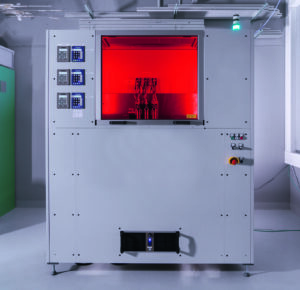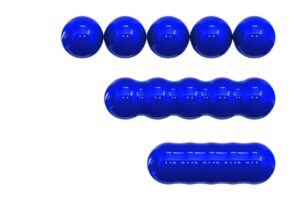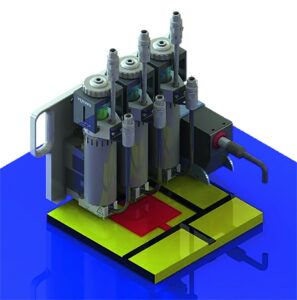Additive manufacturing is currently one of the most significant trends in industry. Now a team from the Fraunhofer Institute for Ceramic Technologies and Systems IKTS has developed a Multi Material Jetting system that allows different materials to be combined into a single additively manufactured part. This makes it possible to create products with combined properties or functions. The new system can be used with particularly high-performance materials such as ceramics and metal.

Additive manufacturing technologies such as 3D printing involve building up a desired product layer by layer instead of producing it from a single piece. This enables high-precision, custom manufacturing with precisely defined product characteristics – and the technology is continuously being improved. Although the early years of additive manufacturing were dominated by polymers, this expanded some time ago to include metals and ceramic-based materials. Fraunhofer IKTS has now taken another major step forward. Researchers have developed a system that enables additive manufacturing of multi-material parts based on thermoplastic binder systems. Known as Multi Material Jetting, or MMJ, this process combines different materials and their various different properties into a single product. “Right now, we can process up to four different materials at a time,” says Uwe Scheithauer, a researcher at Fraunhofer IKTS. This opens the door to a diverse range of applications, allowing companies to produce highly integrated multi-functional components with individually defined properties.
Manufacturing products drop by drop
 The new system fabricates parts in a continuous process. In the first step, the ceramic or metal powder from which the part will be made is distributed homogenously in a thermoplastic binder substance. The slurries produced in this way are loaded into micro-dosing systems (MDS) in order to commence the actual manufacturing process. These slurries are melted in the MDS at a temperature of around 100 degrees Celsius, creating a substance that can be released in very small droplets. The IKTS researchers also developed a corresponding software program to ensure precise positioning of the droplets during manufacturing. The micro-dosing systems operate in a high-precision, computer-controlled process, depositing the droplets one by one in exactly the right spot. This gradually builds up the part drop by drop at rates of up to 60 mm and 1,000 drops a second. The system works with droplet sizes of between 300 and 1000 μm, creating deposited layers with heights of between 100 and 200 μm. The maximum size of parts that can currently be manufactured is 20 × 20 × 18 centimeters. “The critical factor here is the custom dosing of the metal or ceramic slurries. Getting the dosing right is key to ensuring that the additively manufactured final product takes on the required properties and functions during subsequent sintering in the furnace, including properties such as strength, thermal conductivity and electrical conductivity,” says Scheithauer.
The new system fabricates parts in a continuous process. In the first step, the ceramic or metal powder from which the part will be made is distributed homogenously in a thermoplastic binder substance. The slurries produced in this way are loaded into micro-dosing systems (MDS) in order to commence the actual manufacturing process. These slurries are melted in the MDS at a temperature of around 100 degrees Celsius, creating a substance that can be released in very small droplets. The IKTS researchers also developed a corresponding software program to ensure precise positioning of the droplets during manufacturing. The micro-dosing systems operate in a high-precision, computer-controlled process, depositing the droplets one by one in exactly the right spot. This gradually builds up the part drop by drop at rates of up to 60 mm and 1,000 drops a second. The system works with droplet sizes of between 300 and 1000 μm, creating deposited layers with heights of between 100 and 200 μm. The maximum size of parts that can currently be manufactured is 20 × 20 × 18 centimeters. “The critical factor here is the custom dosing of the metal or ceramic slurries. Getting the dosing right is key to ensuring that the additively manufactured final product takes on the required properties and functions during subsequent sintering in the furnace, including properties such as strength, thermal conductivity and electrical conductivity,” says Scheithauer.
Ceramic satellite engine with built-in ignition
 The new IKTS system can be used to make highly complex parts such as the ignition system in a satellite propulsion engine made of ceramics. Satellite engine combustion chambers reach extremely high temperatures, so the ability of ceramics to withstand heat makes them an ideal choice of material. MMJ can be used to produce an ignition system that is directly integrated within the engine. This ignition system combines electrically conductive and insulating areas in a single, extremely robust component. In this case, the MMJ process requires three dosing systems: one for a support material that disintegrates during heat treatment in the furnace, a second for the electrically conductive component, and a third for the electrically insulating component. MMJ also has plenty of conceivable applications in the consumer products market – for example a two-tone ceramic watch bezel made for an individual customer as a one-off item. Thanks to its high precision and flexibility, the MMJ system is suitable for more than just manufacturing multi-functional components. “We could also use it to make blanks for carbide parts, for example. Thanks to the tremendous precision of the dosing systems, the contours of the blanks would already be very close to those of the end product. They would therefore require very little subsequent grinding as compared to conventional methods. That’s a big advantage when you are working with carbide,” says Scheithauer.
The new IKTS system can be used to make highly complex parts such as the ignition system in a satellite propulsion engine made of ceramics. Satellite engine combustion chambers reach extremely high temperatures, so the ability of ceramics to withstand heat makes them an ideal choice of material. MMJ can be used to produce an ignition system that is directly integrated within the engine. This ignition system combines electrically conductive and insulating areas in a single, extremely robust component. In this case, the MMJ process requires three dosing systems: one for a support material that disintegrates during heat treatment in the furnace, a second for the electrically conductive component, and a third for the electrically insulating component. MMJ also has plenty of conceivable applications in the consumer products market – for example a two-tone ceramic watch bezel made for an individual customer as a one-off item. Thanks to its high precision and flexibility, the MMJ system is suitable for more than just manufacturing multi-functional components. “We could also use it to make blanks for carbide parts, for example. Thanks to the tremendous precision of the dosing systems, the contours of the blanks would already be very close to those of the end product. They would therefore require very little subsequent grinding as compared to conventional methods. That’s a big advantage when you are working with carbide,” says Scheithauer.
Validation and commercialization
The project at Fraunhofer IKTS has demonstrated that the technology also works in practice and is scalable. The next step is to validate the technology for industrial use. As well as supplying the hardware, Fraunhofer IKTS can also help industry customers develop the materials and software required for process monitoring and automation. Customers can therefore get everything from a single source, all tailored to their specific requirements. Anyone interested in finding out more about this technology should sign up for the online AM Ceramics meets CERAMITEC Conference on September 16 and 17, 2020 (www.am-ceramics.dkg.de).



